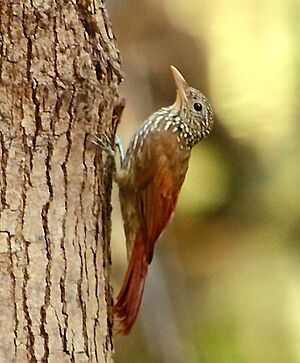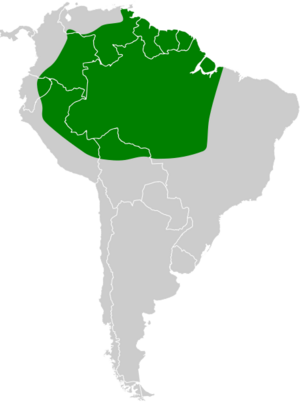Striped woodcreeper facts for kids
Quick facts for kids Striped woodcreeper |
|
|---|---|
 |
|
| at Manacapuru, Amazonas state, Brazil | |
| Conservation status | |
| Scientific classification | |
| Genus: |
Xiphorhynchus
|
| Species: |
obsoletus
|
 |
|
The striped woodcreeper (Xiphorhynchus obsoletus) is a type of bird found in the forests of South America. It belongs to the ovenbird family called Furnariidae. You can find this bird in countries like Bolivia, Brazil, Colombia, Ecuador, French Guiana, Guyana, Peru, Suriname, and Venezuela. It often lives in forests close to water.
Contents
About the Striped Woodcreeper Family
Scientists group living things into different categories. This helps us understand how they are related. The striped woodcreeper has four main groups, called subspecies, which are like different versions of the same species:
- X. o. palliatus
- X. o. notatus
- X. o. obsoletus
- X. o. caicarae
Sometimes, scientists debate if X. o. caicarae is truly its own subspecies.
What Does the Striped Woodcreeper Look Like?
The striped woodcreeper is a medium-sized bird. It has a thin, slightly curved beak. These birds are about 18 to 20.5 cm (7.1 to 8.1 in) long. Males usually weigh between 27 to 37 g (0.95 to 1.3 oz), and females weigh 24 to 36 g (0.85 to 1.3 oz). Both male and female birds look very similar.
The main subspecies, X. o. obsoletus, has a face with thin creamy stripes and dark brown streaks. These streaks become bolder on the sides of its neck. Its head and back of its neck are dark brown with pale spots. Its back is olive-brown with whitish streaks. The bird's rump, wings, and tail are a reddish-brown color. Its throat is a light buffy white. The belly is grayish-olive with buffy-white streaks. Its eyes are brown, and its beak is light brown to gray. Its legs and feet are gray or dark brown. Young birds look similar to adults but have less clear spots and streaks.
Other subspecies have slight differences:
- X. o. notatus is more reddish-brown and has deeper buff-colored streaks.
- X. o. palliatus is even more reddish-brown, and its streaks are darker.
- X. o. caicarae is the smallest subspecies. It has a browner belly and a shorter beak.
These subspecies can mix where their living areas meet.
Where Do Striped Woodcreepers Live?
The different groups of striped woodcreepers live in specific areas:
- X. o. palliatus lives in the Amazon Basin. This includes parts of Colombia, Ecuador, Peru, Bolivia, and western Brazil.
- X. o. notatus is found in eastern Colombia, western and southern Venezuela, and northwestern Brazil.
- X. o. obsoletus lives in the Amazon basin of northeastern Venezuela, the Guianas, northeastern Bolivia, and Brazil.
- X. o. caicarae lives near the Rio Orinoco in central Venezuela.
These birds mostly live in old evergreen forests. They especially like areas near water, such as swamp forests or river islands. They are less common in other types of forests. In the southern parts of their range, they can be found in gallery forests, which are forests that grow along rivers in drier areas. They always live in low-lying areas, never above 500 m (1,600 ft) in elevation.
Behavior and Habits
Movement
Striped woodcreepers stay in the same area all year long. They do not migrate.
Feeding Habits
The striped woodcreeper mainly eats insects and other small creatures like spiders. It usually hunts alone, but sometimes in pairs. It searches for food at all levels of the forest, even high up in the trees. These birds sometimes join groups of different bird species that hunt together. They are not known to follow army ant swarms, which many other birds do to catch insects.
The woodcreeper climbs up tree trunks and branches, sometimes even hanging upside down. It finds its prey by looking closely, poking its beak into cracks, and pecking at surfaces. It also catches a lot of its food by flying out from a branch to grab insects in the air.
Reproduction and Life Cycle
We don't know all the details about when striped woodcreepers breed, but it seems to change depending on where they live. They build their nests in holes, like in a tree stump. They also use the nests of tree-dwelling termites. A female usually lays two eggs. We don't know how long the eggs take to hatch or how long it takes for the young birds to leave the nest. We also don't know much about how the parents care for their babies.
Vocalization
The striped woodcreeper sings mostly at sunrise and sunset. It also sings sometimes during the day. Its song is a trill, which means a series of fast notes. It sounds like "che-e-e-e-e-e-ee-ie-ie-iek!" Its calls include sounds like "sip," "ti-dik," and a dry "tit-it-it" or "si-si-sip."
Conservation Status
The IUCN (International Union for Conservation of Nature) has listed the striped woodcreeper as a species of "Least Concern." This means that it is not currently in danger of disappearing. It lives across a very large area. However, we don't know exactly how many of these birds there are, and their numbers are thought to be going down. There are no immediate big threats to them right now.
The bird is considered common in many parts of its range. But it is rare in other areas. Scientists believe it is somewhat sensitive to forests being lost or broken up. However, because it likes certain types of changing habitats, it might be able to handle some changes better than other forest birds.


